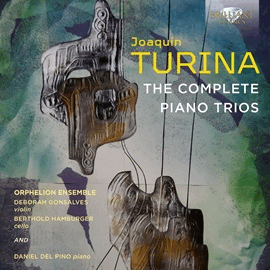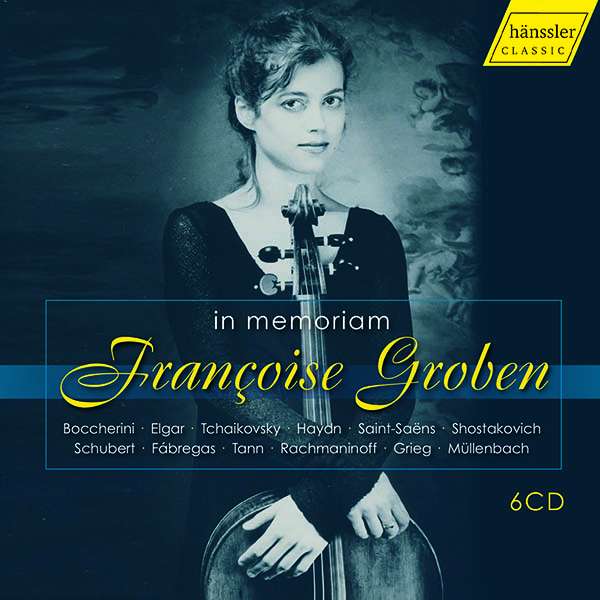Zwei Eckdaten hatten großen Wert in der Karriere der Luxemburger Cellistin Françoise Groben, an die diese CD-Box von Hänssler Classic erinnert. Im Jahre 1990 war sie Preisträgerin beim Internationalen Tchaikovsky-Wettbewerb in Moskau, wo ihr neben der Silbermedaille auch die Spezialpreise der Moskauer Virtuosen und des Künstlerbundes zugesprochen wurden.
Dieser Triumph bei einem der angesehensten Wettbewerbe startete die internationale Karriere von Françoise Groben. Dank einer Luxemburger Bank erhielt sie zudem das Instrument, das ihrer Kunst würdig war, ein etwa 300 Jahre altes Cello des italienischen Geigenbauers Matteo Goffriller. Im selben Jahr debütierte sie beim Schleswig-Holstein-Musik-Festival mit dem Symphonieorchester des Bayerischen Rundfunks unter Dmitrij Kitajenko und machte ab diesem Zeitpunkt eine großartige internationale Karriere in ganz Europa, Nordamerika und dem Fernen Osten. 1993 spielte sie auf Einladung von Mstislav Rostropovich bei der MIDEM in Cannes.
1998 wurde sie Mitglied des von Thomas Zehetmair gegründeten Zehetmair-Quartetts, später bildete sie mit dem Geiger und dem Pianisten Peter Laul ein Trio. Die luxemburgische Cellistin spielte aber weiterhin als Solistin sowie in andern Kammermusikensembles.
Sie ist am 28. Mai 2011 im Alter von 45 Jahren an Krebs gestorben.
In dieser Box mit 6 CDs gibt es u.a. ein ungeheuer spontan und sehr eigenwillig gespieltes Cellokonzert von Elgar, das in keinem Moment die Nähe zu Du Pré sucht, spannende und sehr klangvolle Haydn-Konzerte sowie eine sehr dynamische Interpretation des 2. Boccherini-Konzerts mit einem sehr ausdrucksvollen Adagio. Ganz exzellent sind auch die Einspielungen des Ersten Cellokonzerts von Shostakovich und des zupackend gespielten Ersten Cellokonzerts von Camille Saint-Saëns sowie die sehr leidenschaftlich und ausdrucksvoll interpretierten Rokokovariationen von Piotr Tchaikovsky mit dem Philharmonischen Orchester Luxemburg unter David Shallon.
Das 1. Cellokonzert von Bohuslav Martinu hat Groben mit dem Orchestre de Chambre du Luxembourg unter Nicolas Brochot aufgenommen. Es wird vom Orchester sehr farbig und in den Ecksätzen mit zupackender Rhythmik gespielt, und in diesen Orchesterklang fügt sich der volle Mahagoniklang von Grobens Cello gut ein.
Auch Aufnahmen moderner Werke sind in der Box enthalten, Colores Andaluces von Elisenda Fabregas, The Cresset Stone sowie Gardens of Anna Maria Luisa de’ Medici von Hilary Tann.
Colores Andaluces von der in den USA lebenden spanischen Komponistin Elisenda Fabregas ist sehr stimmungsvoll. Das kurze Solostück The Cresset Stone von Hilary Tann ist eine kleine Tondichtung und meditiert über Ewigkeit von Gestein und die Wechselhaftigkeit von Licht. Gardens of Anna Maria de’ Medici ist eine klingende Hommage an die florentinische Kunstmäzenin. Das Meininger Trio (Christiane Meininger, Françoise Groben und Rainer Gepp) spielt genau wie Groben im Solowerk mit seelenvoller Hingabe, voller Sinnlichkeit und gibt der Musik eine friedvolle Stimmung. Sehr schön und stimmungsvoll ist auch das Spiel von Groben und Ivan Gajan in Colores Andaluces.
Der ukrainische Geiger Graf Mourja, einer der interessantesten Geiger seiner Generation, der Pianist Peter Laul und Françoise Groben haben das Trio Nr. 1 von Brahms aufgenommen. Es gibt in dieser Interpretation viele Dinge, die uns auffallen und begeistern: scharfe Kontraste, unglaublicher Schwung und eine zitternde Intensität. Doch es wird nicht nur leidenschaftlich, dramatisch, gespielt, sondern auch poetisch und einfühlsam. Dieser Brahms, der sehr nah am Text bleibt, entsteht aus einer impulsiven und intuitiven Geste, aus tiefster Seele heraus.
Aus Grobens Zeit mit dem Zehetmair Quartett stammt die Aufnahme von Schumanns 3. Streichquartett. Die Interpretation ist inspiriert, intensiv leidenschaftlich und poetisch zugleich.
Musikalisch interessante, tontechnisch leider nicht besonders gute Aufnahmen gibt es von den Cellosonaten von Sergei Rachmaninov und Edvard Grieg. Françoise Groben und der manchmal etwa zu hämmernd spielende Alfredo Perl zeigen sich leidenschaftlich engagiert, aber der Klang der beiden Instrumente ist nicht wirklich gut verbunden.
Ein kleines Juwel ist Busonis Serenata, in der Françoise Groben von Ira Maria Witoschynskyj begleitet wird. Eine Besonderheit ist eine Bearbeitung Schuberts Arpeggione-Sonata mit Françoise Groben und dem Kammerensemble Les Musiciens unter Pierre Cao.
Und zu Schluss sei noch auf die für mich interessanteste Aufnahme der ganzen Box hingewiesen, die zudem eine Welterstveröffentlichung ist: das Cellokonzert Litanies de l’Ombre et de la Lumière des Luxemburger Komponisten Alex Müllenbach, das 1995 von Françoise Groben und den Philharmonischen Virtuosen Berlin unter der Leitung des Komponisten uraufgeführt wurde.
Es beginnt mit einem klanglich sehr intensiven, aber auch fantasievoll entwickelten ersten Satz, Ikarus. Der zweite Satz heißt Eruptionen und begreift laut dem Komponisten ein « konvulsionsartiges Freisetzen aufgestauter Energien ». Der dritte Satz ist mit Litanies überschrieben und basiert auf Psalmodien, teils responsorial, teils antiphonal: « Schattenkanons, wo sich die imitierende Stimme im Verhältnis zu der führenden wie deren Schatten mitbewegt. Lichtkegel – Lichtprismen. Während der Komposition dieses Satzes hatte ich vor meinem geistigen Auge das Bild eines Gefangenen, der durch die Gitterstäbe seines Gefängnisses eine strahlende Berglandschaft betrachtet. »
Dieses aussagestarkes Konzert wird mit höchster Intensität von der Solistin und den Berliner Philharmonischen Virtuosen gespielt und ob des tiefen und nachhaltigen Eindrucks, den dieses Werk hinterlässt, kann man sich nur wünschen, dass diese Aufnahme vielleicht dazu beitragen kann, dieses herausragende Cellokonzert bekannt zu machen.
Two key dates had great value in the career of Luxembourg cellist Françoise Groben, commemorated by this CD box set from Hänssler Classic. In 1990, she was a prize-winner at the International Tchaikovsky Competition in Moscow, where, in addition to the silver medal, she was awarded the special prizes of the Moscow Virtuosi and the Union of Artists.
This triumph at one of the most prestigious competitions launched Françoise Groben’s international career. Thanks to a Luxembourg bank, she then obtained the instrument worthy of her art, a cello about 300 years old made by the Italian violin maker Matteo Goffriller. That same year she made her debut at the Schleswig-Holstein Music Festival with the Bavarian Radio Symphony Orchestra under Dmitri Kitajenko, and from that point on she went on to have a magnificent international career throughout Europe, North America and the Far East. In 1993, at the invitation of Mstislav Rostropovich, she played at the MIDEM in Cannes.
In 1998 she became a member of the Zehetmair Quartet founded by Thomas Zehetmair, later forming a trio with violinist and pianist Peter Laul. However, the Luxembourg cellist continued to play as a soloist as well as in other chamber ensembles.
She died of cancer on May 28, 2011, at the age of 45.
In this box of 6 CDs there is, among other works, a tremendously spontaneous and very idiosyncratically played cello concerto by Elgar, which at no moment seeks to be close to Du Pré, exciting and very sonorous Haydn concertos, and a very dynamic interpretation of the 2nd Boccherini concerto with a very expressive Adagio. The recordings of the First Cello Concerto by Shostakovich and the grippingly played First Cello Concerto by Camille Saint-Saëns are also quite excellent, as are the very passionately and expressively interpreted Rococo Variations by Piotr Tchaikovsky with the Luxembourg Philharmonic Orchestra under David Shallon.
Groben recorded the 1st Cello Concerto by Bohuslav Martinu with the Orchestre de Chambre du Luxembourg under Nicolas Brochot. It is played by the orchestra in a very colorful manner, with gripping rhythms in the corner movements, and the full mahogany sound of Groben’s cello blends well with this orchestral sound.
Recordings of modern works are also included in the box, Colores Andaluces by Elisenda Fabregas, The Cresset Stone, and Gardens of Anna Maria Luisa de’ Medici by Hilary Tann.
Colores Andaluces by U.S.-based Spanish composer Elisenda Fabregas is very atmospheric. The short solo piece The Cresset Stone by Hilary Tann is a small tone poem which meditates on eternity of stone and the changeability of light. ‘Gardens of Anna Maria de’ Medici’ is a tribute to the Florentine patroness of the arts. The Meininger Trio (Christiane Meininger, Françoise Groben and Rainer Gepp) plays, just as Groben does in the solo work, with soulful abandon, full of sensuality and giving the music a peaceful mood. Very beautiful and atmospheric is also the playing of Groben and Ivan Gajan in Colores Andaluces.
Ukrainian violinist Count Mourja, one of the most interesting violinists of his generation, pianist Peter Laul, and Françoise Groben have recorded Brahms’ Trio No. 1. There are many exciting things in this interpretation: sharp contrasts, incredible momentum, and a tremulous intensity. But there is not only passionate, dramatic, playing, but also poetic and sensitive. This Brahms, which stays very close to the text, emerges from an impulsive and intuitive gesture, from deep within the soul.
From Groben’s time with the Zehetmair Quartet comes the recording of Schumann’s 3rd String Quartet. The interpretation is inspired, intensely passionate and poetic at the same time.
Musically interesting, but unfortunately technically not very good recordings exist of the cello sonatas by Sergei Rachmaninov and Edvard Grieg. Françoise Groben and Alfredo Perl, whose playing sometimes is too hammered, show passionate commitment, but the sound of the two instruments is not really well connected.
A little gem is Busoni’s Serenata, with Françoise Groben and pianist Ira Maria Vitoshynskyj.
We should also mention an arrangement of Schubert’s Arpeggione Sonata in which Françoise Groben is accompanied by the chamber ensemble Les Musiciens under Pierre Cao. And finally, the most interesting recording of the whole box for me, which is also a world premiere release: the cello concerto Litanies de l’Ombre et de la Lumière by Luxembourg composer Alex Müllenbach, premiered in 1995 by Françoise Groben and the Philharmonische Virtuosen Berlin conducted by the composer.
It begins with an intense but also imaginatively composed first movement, Icarus. The second movement is called Eruptions and, according to the composer, conceives of a « convulsion-like release of pent-up energies. » The third movement is entitled Litanies and is based on psalmody, partly responsorial, partly antiphonal: « shadow canons, where the imitating voice moves in relation to the leading one like its shadow. Light cones – light prisms. While composing this movement, I had in my mind’s eye the image of a prisoner looking at a radiant mountain landscape through the bars of his prison. »
This expressive concerto is played with the utmost intensity by the soloist and the Berlin Philharmonic Virtuosi and, given the deep and lasting impression this work leaves, one can only wish that this recording might help to popularize this outstanding cello concerto.


















